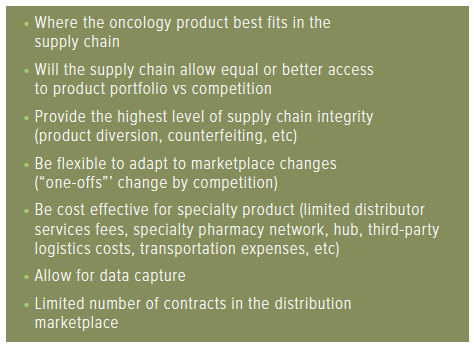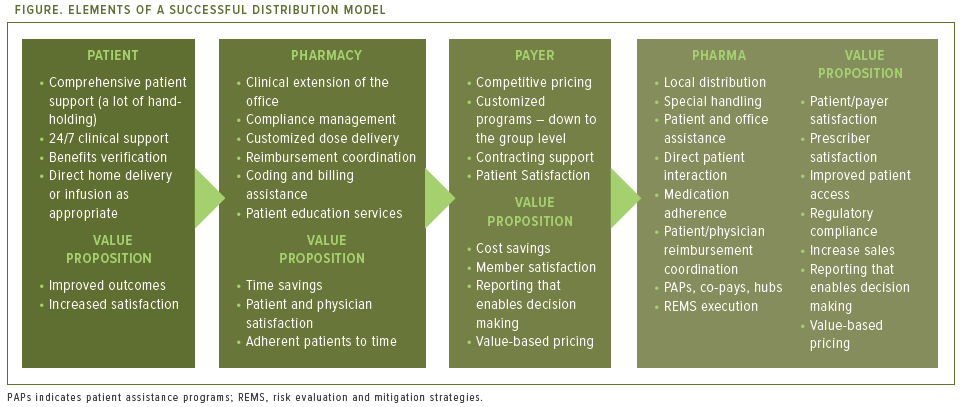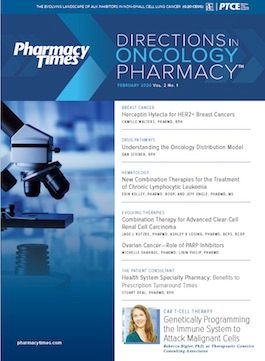Publication
Article
Pharmacy Practice in Focus: Oncology
Understanding the Oncology Distribution Model
Author(s):
As the growth of specialty continues at a record pace, pharmacy must keep up with new distribution trends as an oncology product’s supply chain of a product can take many paths.
AS WE LOOK back at 2019 and the landslide of new drug approvals, so many of them fall into the specialty space and oncology. To better comprehend how pharmacy can best engage with these oncology products, it is important to understand the process that most manufacturers undertake in determining how their product flows through the supply chain. One of the early goals of a specialty products manufacturer, and oncology product launch is selecting the optimal distribution model.
As the growth of specialty continues at a record pace, pharmacy must keep up with new distribution trends as an oncology product’s supply chain of a product can take many paths. Although there is a tremendous trend to develop oral solid treatments in oncology the mainstay of cancer treatment continues to be infused specialty products. Many products share properties with each other; however, external factors that go beyond the fiscal and physical needs of an optimal supply chain come into play.
Optimal Critical Path for Oncology Products
Finding the optimal critical path for an oncology product begins 2 or 3 years from approval and such lead-times are often necessary given many new drug application (NDA) and biologic license application (BLA) filings require information on the supply chain as an element of the FDA filing. Often led by the supply chain team, this process should include a strategic evaluation of the available options. If a manufacturer does not have a team, a handful of experienced consultants are available who can drive the process of strategy, selection, and implementation. It is imperative to explore many of the variables around how to best support an oncology product launch, and there are a number of supply chain criteria or trends that must be considered:

Choosing the Optimal Supply Channel
The traditional supply chain route for a product is manufacturer to drug distributor to pharmacy. This traditional trend has greatly evolved with the advent of specialty products. Specialty product demands are “game changers” when it comes to distribution strategy as these products are defined as often requiring frequent dosage adjustments, typically more severe adverse effects than traditional drugs, narrow therapeutic range, higher costs than traditional products ($10,000-$1,000,000 annually), patient registration, special storage, handling and/or administration, smaller numbers of patients (5000-100,000), enhanced patient training and clinical call center, deeper clinical data reporting and analysis to augment broader compliance with regulations, and adherence management. Whether a product is oral or ingested or injected often drives the first tier in the supply chain. Products that fit the specialty criteria can flow through multiple channels and these channels are becoming blurred.
Typically, oral products have flowed through the specialty pharmacy space if the patient population is under 100,000 lives and with a limited number of these pharmacies having access to the product. In most cases, the manufacturer sets up a direct relationship with the network specialty pharmacy and through a purchase agreement, distributes and sells products direct to the pharmacy, thereby eliminating the specialty distributor and those associated costs.
Many oncology practices are wanting to manage both the infused and oral products on behalf of their patients. Hospitals and centers of excellence have taken the same path and built out specialty pharmacies to enhance their services portfolio. Infused oncology products have traditionally been administered to patients in the community oncologist’s clinic, however there has been a significant trend to where these practices have merged with local hospitals. Therefore, many oncology patients are receiving their infusions in the outpatient infusion centers associated with the hospital. Generally, both oral and infused products that are administered in a community clinic or hospital are distributed to those providers by specialty distributors in either an open or limited distribution process. Although the distributor or “middle man” adds to the cost, the efficiencies to the customer require this approach.
The Process of Selecting a Distribution Strategy and Implementation
An organization is often thought to be a unit of people that is structured and managed to meet a need or to pursue collective goals. All organizations have a management structure that determines relationships between the different activities and the members, and subdivides and assigns roles, responsibilities, and authority to carry out different tasks. When developing a successful specialty distribution model, the attainment of consensus is mission critical to success. The described process often yields what is either an open, limited, exclusive or hybrid distribution model. Based on these 4 options, the business relationships are assembled typically through a rigorous process that provides both objective and subjective parameters based on capabilities, quality and price.
Oncology manufacturers must consider which service organizations best fit their model based on the following criteria, as well as the critical path in selecting their commercialization plan.
• Third-party Logistics
° Order to cash—customer service, accounts receivable, contract management
° Pick, pack, ship, transportation, reporting, returns, etc
• Specialty distributors
° Oncology manufacturers may have a contract directly with specialty distributors to provide services and distribute specialty products including community oncology and hospital or other institutional purchasers. These services can include either selling product to them or managing drop-shipments to them from the third-party logistics.
• Specialty Pharmacy
° Manufacturer may have contracts with specialty pharmacy via third-party logistics (above)
The "4 Ps:" Patient, Payer, Physician, and Pharmacy
Ultimately the manufacturer must consider the “4 Ps” we have often spoken about: patient, payer, physician, and pharmacy. Each has a unique and interwoven set of needs in order to have a successful distribution model. Each of these 4 stakeholders’ needs must be met to assure an optimal patient outcome. The Figure below best describes each of these needs and the subsequent value proposition.

Finding Your Role in Oncology Pharmacy
Once the oncology manufacturer considers the needs of the various stakeholders combined with their business objectives, they are ready to begin mapping out their flow and distribution model. This journey often begins substantially before their potential approval date. To assure your practice is considered it is essential that it can meet all the criteria required to best fit the needs of the oncology product. At a minimum the operation should have a track record of collaboration with oncology practices, compliance management, reimbursement expertise, ongoing patient education and management.
Dan Steiber, RPh operates Genesis Pharma Consultants, a consulting practice responsible for commercial operations and trade-supply chain strategy development. Steiber has served in several senior positions in pharmacy, distribution, and industry over the course of his 40- year career. Steiber is a licensed pharmacist in Texas, Washington, California, and Pennsylvania. He is affiliated with several professional associations and publications and a frequent speaker on behalf of many professional organizations. Steiber graduated from Washington State University College of Pharmacy. He has participated in a variety of postgraduate programs in law and business development/marketing at Harvard University and Northwestern University.







